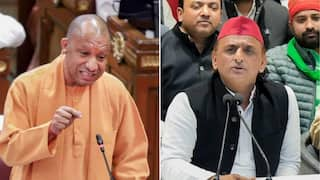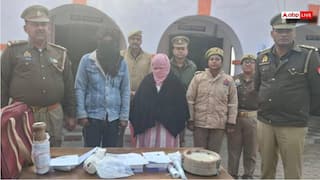T. Rex Was Hot-Blooded, Stegy Was Cold-Blooded: Dinosaur Metabolism Explained By New Chemical Study
Stegosaurus was a cold-blooded creature. And the familiar Tyrannosaurus rex from the Jurassic Park series was hot-blooded. These findings emerge from a study recently published in the journal Nature.

New Delhi: In the Phantom Comics, the masked hero had a pet Stegosaurus named "Stegy" in his private garden called Eden. It turns out that the Stegosaurus was a cold-blooded creature. And the familiar Tyrannosaurus rex from the Jurassic Park series was hot-blooded. These findings emerge from a study recently published in the journal Nature.
Palaeontologists have debated for decades whether dinosaurs were warm-blooded, like modern mammals and birds, or cold-blooded, like modern reptiles. Knowledge of whether dinosaurs were warm-blooded or cold-blooded could give us clues about how active they were and how they lived their everyday lives. However, the methods to determine their warm- or cold-bloodedness were hitherto inconclusive. Warm- or cold-bloodedness determined how quickly the dinosaurs' metabolisms could turn oxygen into energy.
What Do Clues In Dinosaurs’ Bones Indicate?
In the new paper in Nature, an international team of scientists have unveiled a new method for studying dinosaurs' metabolic rates, using clues in their bones that indicated how much oxygen the individual animals breathed in their last hour of life.
In a statement released by Field Museum in Chicago, Jasmina Wiemann, the lead author on the paper, and a researcher at the California Institute of Technology, said the study is really exciting for palaeontologists. She added that the question of whether dinosaurs were warm-blooded or cold-blooded is one of the oldest questions in palaeontology, and now, scientists think they have a consensus, that most dinosaurs were warm-blooded.
Matteo Fabbri, a researcher at the Field Museum, said the new proxy developed by Jasmina Wiemann allows scientists to directly infer metabolism in extinct organisms, something that they were only dreaming about a few years ago. He added that the researchers also found different metabolic rates characterising different groups, which were previously suggested based on other methods, but never directly tested.
What Does Metabolism Signify?
Wiemann explained that people sometimes talk about metabolism in terms of how easy it is for someone to stay in shape, but at its core, metabolism is how effectively one converts the oxygen that they breathe into chemical energy that fuels their body.
Endothermic And Ectothermic Animals
Animals which have a high metabolic rate are endothermic, warm-blooded or hot-blooded. Warm-blooded animals like birds and mammals inhale lots of oxygen and have to burn a lot of calories in order to maintain their high body temperature and stay active, the study said.
Meanwhile, cold-blooded or ectothermic animals like reptiles breathe less and eat less. The lifestyle of cold-blooded animals is less energetically expensive than that of a hot-blooded animal. However, this comes at a price. Cold-blooded animals are dependent on the outside world to keep their bodies at the right temperature to function, and tend to be less active than warm-blooded creatures. For example, a lizard basks in the Sun to keep its body at the right temperature to function.
Since birds are warm-blooded and reptiles are cold-blooded, dinosaurs were caught in the middle of a debate.
Which Dinosaurs Survived Mass Extinction At End Of Cretaceous Period?
Birds are the only dinosaurs which survived the mass extinction at the end of the Cretaceous period, and dinosaurs are technically reptiles, the study said. Outside of birds, the closest living relatives of dinosaurs are crocodiles and alligators. Therefore, the researchers wondered whether that would make dinosaurs warm-blooded or cold-blooded.
How Did Scientists Determine Dinosaurs’ Metabolic Rates?
Researchers have conducted chemical and osteohistological analyses of dinosaurs' bones to determine their metabolic rates. Osteohistology refers to the study of microscopic structure, chemical composition, and function of bone. Osteohistological analyses reveal diverse strategies of theropod dinosaur body-size evolution.
Weimann said that in the past, people have looked at dinosaur bones with isotope geochemistry that basically works like a "paleo-thermometer". This is a method using which researchers examine the minerals in a fossil and determine what temperatures those minerals would form in.
Weimann added that it is a really cool approach and it was really revolutionary when it came out, and it continues to provide exciting insights into the physiology of extinct animals.
How Growth Rate Helps Determine Metabolism
According to the researchers, another method for studying metabolism is growth rate. Fabbri said if one looks at a cross section of dinosaur bone tissue, they can see a series of lines, like tree rings, that correspond to years of growth. People can count the lines of growth and the space between them to see how fast the dinosaur grew. He added that growing faster or slower can have more to do with the animal's stage in life than with its metabolism, comparing the theory with people growing faster when they are young and slower when they are older.
Why The Scientists Looked At Oxygen Use Instead Of Minerals Or Growth Rate
According to the study, the new method proposed by Weimann, Fabbri, and other researchers does not look at the minerals present in bone or how quickly the dinosaur grew. Instead, the team looked at oxygen use, which is one of the most basic hallmarks of metabolism.
When animals breathe, they generate side products which react with proteins, sugars, and lipids, and leave behind molecular "waste". According to the researchers, the waste is extremely stable and water-insoluble. Therefore, the waste is preserved during the fossilisation process, leaving behind a record of how much oxygen a dinosaur was breathing in. This, in turn, helps researchers determine the dinosaur's metabolic rate.
The scientists looked for these bits of molecular waste in dark-coloured fossil femurs, because those dark colours indicate that a lot of organic matter is preserved, the study said.
How Were The Fossils Examined?
The fossils were examined using Raman and Fourier-transform infrared spectroscopy. Raman spectroscopy is a spectroscopic technique used to determine vibrational modes of molecules. Spectroscopy is the study of absorption and emission of light and other radiation by matter. Fourier-transform infrared spectroscopy is a technique which is used to obtain an infrared spectrum of absorption, emission, and photoconductivity of solid, liquid, and gas. It identifies chemical bonds in a molecule.
Weimann explained that these methods work like laser microscopes, and researchers can basically quantify the abundance of molecular markers which tell them about the metabolic rate. She said this is a particularly attractive method to palaeontologists because it is non-destructive.
55 Different Animal Groups Including Dinosaurs Analysed
The scientists analysed the femurs of 55 different groups of animals, including dinosaurs, their flying cousins called pterosaurs, their more distant marine relatives called the plesiosaurs, and modern birds, mammals, and lizards. The scientists compared the amount of breathing-related molecular byproducts with the known metabolic rates of the living animals, in order to determine the metabolic rates of the extinct ones.
What Are Saurischians And Ornithischians?
According to the study, the dinosaurs' metabolic rates were generally high. There are two big groups of dinosaurs, namely the saurischians and the ornithischians. Saurischians refer to lizard hips and ornithischians refer to bird hips.
The bird-hipped dinosaurs, such as Triceratops and Stegosaurus, had low metabolic rates which were comparable to those of cold-blooded modern animals, the study said.
The lizard-hipped dinosaurs, which included theropods and the sauropods were warm-blooded or even hot-blooded. The sauropods were the two-legged, more bird-like predatory dinosaurs like Velociraptor and T. rex and the giant, long-necked herbivores like Brachiosaurus.
Saurischians And Ornithischians Were Warm-Blooded
The scientists were surprised to find that some of these dinosaurs were not just warm-blooded, but had metabolic rates comparable to modern birds, much higher than mammals. Due to the lack of a direct proxy to infer metabolism, the results could not provide direct evidence. However, the findings complement previous independent observations that hinted at such trends.
According to the researchers, the findings can give them fundamentally new insights into what dinosaurs' lives were like.
How Did Dinosaurs With Lower Metabolic Rates Survive?
Weimann said dinosaurs with lower metabolic rates would have been, to some extent, dependent on external temperatures. She added that lizards and turtles sit in the Sun and bask, and that researchers may have to consider similar 'behavioural' thermoregulation in ornithischians with exceptionally low metabolic rates.
Weimann explained that cold-blooded dinosaurs also might have had to migrate to warmer climates during the cold season, and climate may have been a selective factor for where some of these dinosaurs could live.
Characteristics Of Hot-Blooded Dinosaurs
Weimann further said that hot-blooded dinosaurs would have been more active and would have needed to eat a lot. She explained that the hot-blooded giant sauropods were herbivores, and it would take a lot of plant matter to feed this metabolic system. Sauropods had very efficient digestive systems, and since they were so big, it probably was more of a problem for them to cool down than to heat up.
According to the study, theropod dinosaurs, which was the group containing birds, developed high metabolisms even before some of their members evolved flight.
Significance Of The Study
Fabbri said that reconstructing the biology and physiology of extinct animals is one of the hardest things to do in palaeontology. The significance of the new study is that it added a fundamental piece of the puzzle in understanding the evolution of physiology in deep time and complements previous proxies used to investigate these questions. Fabbri further said that researchers can now infer body temperature through isotopes, growth strategies through osteohistology, and metabolic rates through chemical proxies.
The study not only gives researchers insights into what dinosaurs were like, but also helps people understand the world around them. The authors noted in the study that dinosaurs, with the exception of birds, died out in a mass extinction 65 million years ago when an asteroid struck Earth.
Did Birds Survive Mass Extinction Due To Increased Metabolic Capacity?
Weimann said that having a high metabolic rate has generally been suggested as one of the key advantages when it comes to surviving mass extinctions and successfully radiating afterwards.
According to some scientists, birds survived while the non-avian dinosaurs died because of the birds' increased metabolic capacity. Weimann said this study helps to show that the fact that non-avian birds died due to their increased metabolic capacity is not true. This is because many dinosaurs with bird-like, exceptional metabolic capacities were extinct.
Weimann explained that we are living in the sixth mass extinction; hence, it is important for us to understand how modern and extinct animals physiologically responded to previous climate change and environmental perturbations. In this way, the past can inform biodiversity conservation in the present and inform our future actions.







































